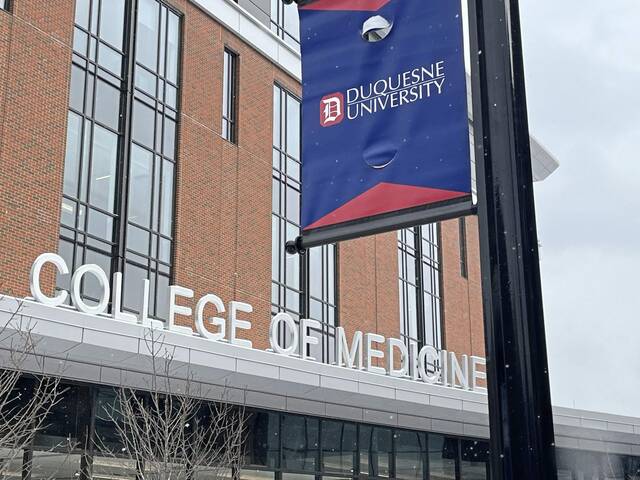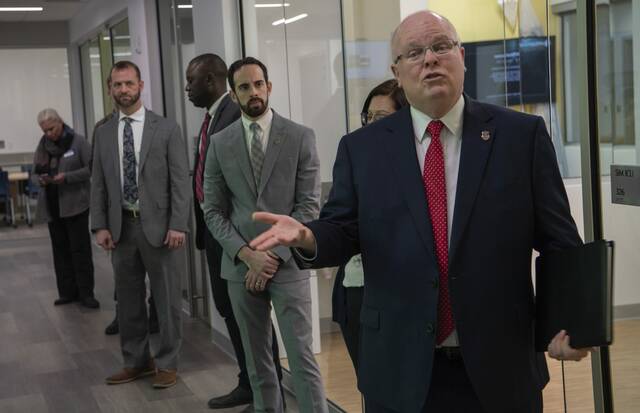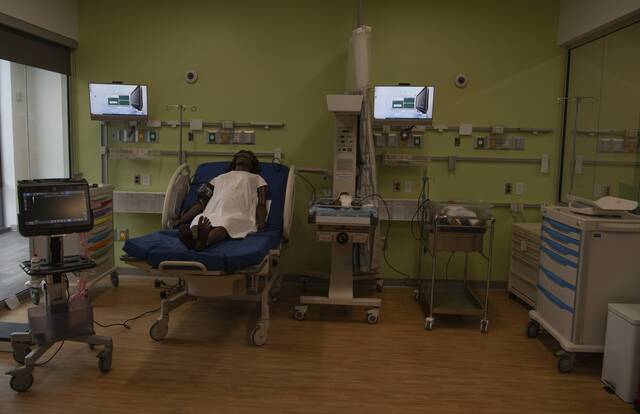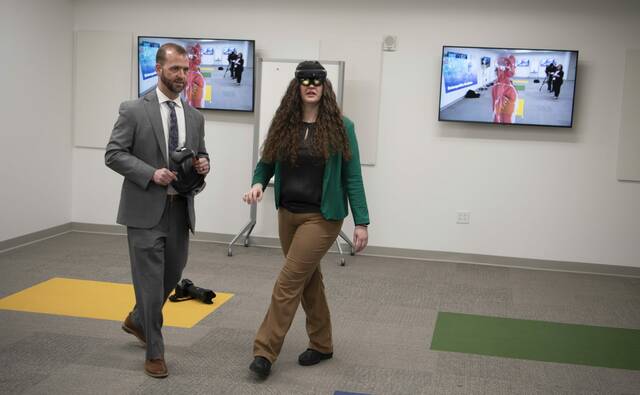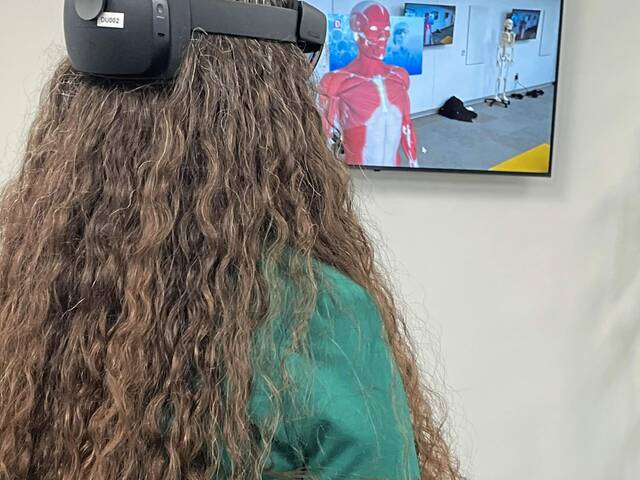'This will be a game-changer': Duquesne University opens medical college
Students in the inaugural class of Duquesne University’s medical college will learn the intricacies of human anatomy through the time-tested method of dissecting cadavers.
But they also will slip on a high-tech headset with eyewear and instantly see before them a hologram of the human body. They can walk around the projected flesh-colored image and “touch” its exterior virtually. They can even stick their head inside for an extraordinarily detailed look at the body’s inner workings — one that previous generations of medical students couldn’t have imagined.
The virtual anatomy lab — called HoloAnatomy — is part of a major investment in technology that Duquesne hopes will attract students to its brand-new College of Osteopathic Medicine, which officially opened Wednesday. It will enroll its first class of about 85 students in July.
Duquesne has attracted 2,500 applicants nationally for about 85 first-year slots. Of the 80 who have been accepted and put down deposits, almost two-thirds are from Pennsylvania or earned their undergraduate degrees in the region.
That fits with Duquesne’s stated desire to enroll those committed to working as primary care doctors in underserved rural and urban communities in Pennsylvania and the region.
At a startup cost of more than $150 million, the college is the most ambitious effort in Duquesne’s 145 years. Its goal is to help address a critical shortage of primary care and family physicians in Pennsylvania and across the country, Duquesne President Ken Gormley said.
During a tour Tuesday of the five-story building on Forbes Avenue, leaders expressed pride in the faculty they recruited, the curriculum they developed and the sophisticated equipment, from the hand-held ultrasound devices each student will be issued to the hologram lab.
???? Photos: Celebrate a history-making day at Duquesne with the official ribbon-cutting ceremony for the College of Medicine. #DuqMedicalCollege pic.twitter.com/bdrFXd7T9W
— Duquesne University (@duqedu) January 17, 2024
Pioneered at Case Western Reserve University, HoloAnatomy software and similar technology are used in a small number of U.S. medical colleges.
“It’s a hologram like in Star Wars,” said Jason Wells, associate dean for biomedical affairs at Duquesne, pointing to a free-floating image of a human body, which can be viewed by an entire class able to see the same image, or even remotely.
“When you see Princess Leia or another hologram, it’s the exact same thing. But you are still in the room. It’s not like virtual reality, where the computer gives you your own room,” he said.
Dr. John Kauffman, the school’s founding dean, said, “This is really an exciting time to launch a medical school. We have more technology at our fingertips than ever before. … And, the more technology we can put into their hands, the better they’ll be able to be prepared to diagnose and treat their patients.”
Amanda Troy, chair and associate professor of anatomy at Duquesne, said donated cadavers “are amazing gifts” but holographic images allow students to build on what they have learned with their hands. They will be able to interact with images that show precise detail and have fewer signs of muscle atrophy than a cadaver.
Kauffman said he believes prospective students were impressed by the curriculum being developed. But, with the building not yet finished, they had to rely on renderings in making their medical school choice.
Not anymore.
On Tuesday, Kauffman previewed the simulation hospital, operating room, intensive care unit and examination areas students will use during their three years. It’s where they will experience what it’s like to deliver a baby, suture a wound and diagnose hundreds of simulated medical conditions, aided by computer-powered mannequins.
It’s a far cry from Kauffman’s days in medical school in the 1980s.
“We had none of this,” he said.
“I think this will be a game-changer. When students arrive here and walk through this space, especially after they visited other medical schools, I think it will become the deciding factor,” Kaufman said.
Duquesne unveiled its plan for a medical college in July 2019.
It said the school would train students consistent with Catholic service and outreach traditions of the Spiritans, who founded Duquesne in 1878 to educate the children of Pittsburgh’s immigrants.
The founders initially wanted a law and medical school, but instead established a law school in 1911. Plans for a medical school finally are being realized.
The covid-19 pandemic that shuttered campuses and much of the nation in March 2020 delayed the opening by a year. But the health crisis also reinforced the need for such a project, said Gormley, who has spearheaded its development.
Donors maintained their support for the project, infusing millions of dollars.
There are 41 accredited schools of osteopathic medicine delivering instruction at 66 locations in 35 states, according to the American Association of Colleges of Osteopathic Medicine. They account for 25% of the nation’s medical students.
Nationally, the association projects a shortage of about 120,000 physicians, in particular primary care doctors, by 2032. It is expected to be most pronounced in urban and rural areas where gaps in care already exist.
Before Wednesday’s ribbon-cutting ceremony, university leadership, deans of Duquesne’s nine schools and faculty and student representatives will walk in procession from Old Main, the oldest campus building, to the new college across from UPMC Cooper Fieldhouse. Officials hope the school ultimately will grow to 680 students.
In attendance Wednesday, will be Rose Trimpey-Warhaftig, 25, of Raleigh, N.C., the first student accepted into the new school. Though she grew up in North Carolina, Trimpey-Warhaftig said her mother attended Duquesne, and her family spent part of her childhood in Western Pennsylvania.
New school or not, she said, Duquesne already offers nursing, pharmacy and other health science-related programs. It makes her feel even better about pursuing her medical degree in Pittsburgh, said Trimpey-Warhaftig, who received an undergraduate degree from Duke University.
“I’m very at home here, and I absolutely would love to stay here,” she said.
Remove the ads from your TribLIVE reading experience but still support the journalists who create the content with TribLIVE Ad-Free.

